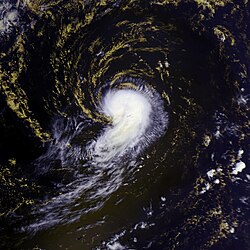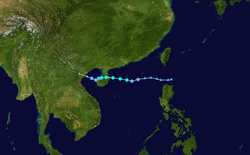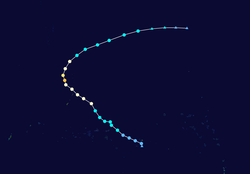Usagi 01 aug 2007 0125Z
Category 4 Typhoon Usagi was stretched across the Pacific Ocean southeast of Japan in a long oval shape when the Moderate Resolution Imaging Spectroradiometer (MODIS) on NASA’s Terra satellite captured this image on August 1, 2007. The spiraling bands of rain clouds in the northwest quadrant of the storm appear to be reaching out for the islands of Shikoku and Honshu. Several large cities occupy these southern islands, which means millions of residents had to keep nervous eyes on the storm.
Typhoon Usagi was at its maximum intensity when Terra MODIS captured this image on the morning on August 1. With its tightly wound bands of clouds, nearly symmetrical shape, and well-defined eye, Usagi bore the hallmarks of an extremely powerful tropical cyclone. At the time, the storm packed sustained winds of 222 kilometers per hour (120 knots or 138 miles per hour) with gusts to 269 km/hr (145 knots of 167 mph). Usagi weakened slightly in the hours that followed, and was forecast to weaker further before striking Japan late on August 2 or early on August 3, said the Joint Typhoon Warning Center.
Usagi is the fifth named storm in the western Pacific in 2007, and it is the second Category 4 storm to form in July. Its predecessor, Man-Yi, also troubled Japan. It pounded Okinawa and then veered northeastward, raking the east coast of the southern islands. According to the Japan Meteorological Agency, August and September are the most active months for tropical cyclones in this part of the Pacific, with an average of 5.5 and 5.1 storms, respectively.
The large image provided above has a spatial resolution (level of detail) of 250 meters per pixel. The MODIS Rapid Response Team provides this image in additional resolutions.| Diese Datei ist gemeinfrei (public domain), da sie von der NASA erstellt worden ist. Die NASA-Urheberrechtsrichtlinie besagt, dass „NASA-Material nicht durch Urheberrecht geschützt ist, wenn es nicht anders angegeben ist“. (NASA-Urheberrechtsrichtlinie-Seite oder JPL Image Use Policy). |  | |
 |
Warnung:
|
Relevante Bilder
Relevante Artikel
Pazifische Taifunsaison 2007Die Pazifische Taifunsaison 2007 dauerte vom 1. Januar bis 31. Dezember 2007, obwohl sich die meisten Zyklone im nordwestlichen Pazifischen Ozean zwischen Mai und November bilden. Tropische Stürme, die sich auf der Nordhalbkugel im Pazifischen Ozean westlich der Datumsgrenze bildeten, nennt man Taifune. Die sich 2007 im Pazifischen Ozean östlich der Datumsgrenze und nördlich des Äquators gebildeten Hurrikane sind Gegenstand der Pazifischen Hurrikansaison 2007. Tropische Stürme, die sich im Bereich des westlichen Pazifischen Ozeanes bilden, werden durch die Japan Meteorological Agency (JMA) mit einem Namen versehen. Tropische Tiefdruckgebiete in diesem Becken erhalten das Suffix „W“ zu der laufenden Nummerierung durch das Joint Typhoon Warning Center. Tropische Systeme, die sich im Verantwortungsbereich der Philippinen bilden oder in diesen hineinwandern, erhalten einen Namen durch die Philippine Atmospheric, Geophysical and Astronomical Services Administration (PAGASA). Dies kann dazu führen, dass Stürme zwei verschiedene Namen haben. .. weiterlesen










































